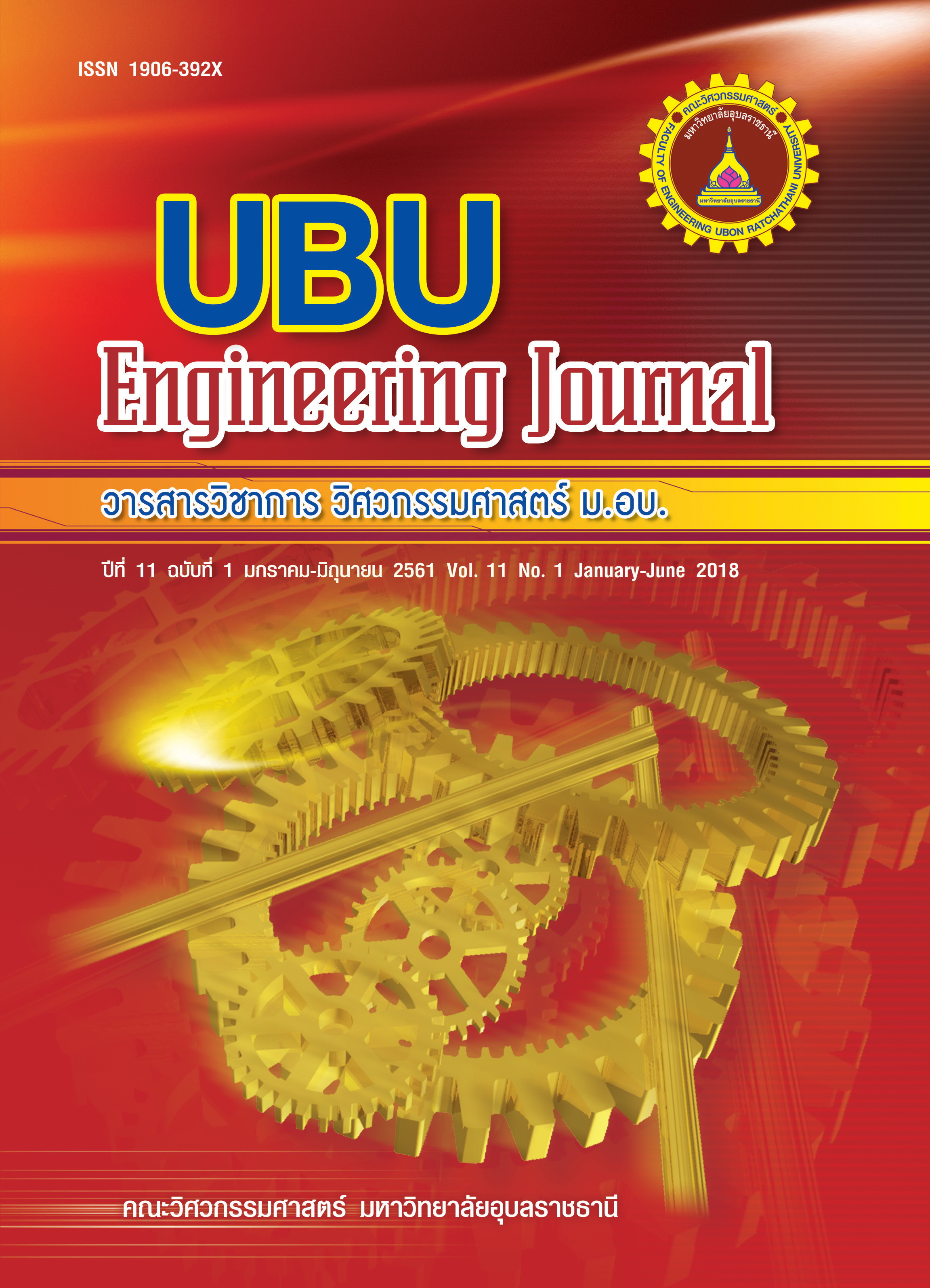การเลือกตำแหน่งที่ตั้งของตัวแทนกลุ่มเกษตรกรเพื่อจัดการปุ๋ยในโซ่อุปทานอุตสาหกรรมปาล์มน้ำมัน จังหวัดสุราษฎร์ธานี
Main Article Content
Abstract
The Royal Thai Government has introduced the large cultivation policy in order to empower the strengthening of smallholder farmers with an effective production management and marketing. This research, influenced by the policy, aims to find locations of establishing agents of oil palm smallholder farmers in the procurement and distribution of fertilizers to plantations within Surat Thani province with the objective function of minimizing the total costs (including procurement cost, installing and operating cost, transportation cost) to serve demands under the limited areas (i.e., distance to deliver from agent to each group of farmers). This problem considers five different distance boundaries of the distribution, covering all of 121 sub-districts. All sub-districts can be equally selected to be agents. This paper tackles the problem via the capacitated facility location model with distance boundaries of the distribution; then it is solved by using Premium Solver Platform software. The results showed that the total number of agents established are: 95, 62, 53, 49 and 48 agents, to distribute fertilizer under the limited distance of 10, 15, 20, 25 and 30 kilometers, respectively.
Article Details
References
[2] ศูนย์สารสนเทศการเกษตร สำนักงานเศรษฐกิจการ เกษตร. พื้นที่เพาะปลูกปาล์มน้ำมันในภาคใต้ปี พ.ศ. 2556. เข้าถึงได้จาก http://www.oae.go.th/ down load/prcai/farmcrop/palm.pdf [เข้าถึงเมื่อ 2557].
[3] นิกร ศิริวงศ์ไพศาล, เสกสรร สุธรรมานนท์, พัลลภัช เพ็ญจำรัส. การศึกษาระบบโซ่อุปทานของอุตสาหกรรมปาล์มน้ำมันและน้ำมันปาล์ม ในการปรับตัวรองรับประชาคมเศรษฐกิจอาเซียน. สำนักงานพัฒนาการวิจัยการเกษตร, กรุงเทพฯ. 2557.
[4] สมาคมปาล์มน้ำมันจังหวัดสุราษฎร์ธานี. สมาชิกชาวสวนปาล์มน้ำมัน. เข้าถึงได้จาก http://www.suratthani .doae.go.th/newplam/indexpind.htm [เข้าถึงเมื่อ 2557].
[5] Matopoulos A, Vlachopoulou M, Manthou V, Manos B. A conceptual framework for supply chain collaboration: empirical evidence from the agri-food industry. Supply Chain Management: An International Journal. 2007; 12(3): 177–186.
[6] Cao M, Zhang Q. Supply chain collaborative advantage: a firm’s perspective. International Journal of Production Economics. 2010; 128: 358–367.
[7] Ramanathan U, Gunasekaran A. Supply chain collaboration: impact of success in long-term partnerships. International Journal of Production Economics. 2014; 147: 252–259.
[8] จันทร์ศิริ สิงห์เถื่อน. การเลือกตำแหน่งที่ตั้งของสถานที่ให้บริการด้วยวิธีการหาคำตอบที่ดีที่สุด. วิศวกรรมสาร มก. 2554; 24(78): 107−122.
[9] Christou IT. Quantitative Methods in Supply Chain Management. In: Models and Algorithms. London: Springer-Verlag; 2012.
[10] ปณิธาน พีรพัฒนา, รัฐไท ธนานุรูปไพศาล, ชาติชาย บุญยู, วีรพัฒน์ เศรษฐสมบูรณ์. ปัญหาการจัดกลุ่มเกษตรกรไร่อ้อยและการหาทำเลที่ตั้งสำหรับสถานีพักอ้อยในรูปแบบพลวัต. วิศวกรรมสาร มข. 2549; 33(3): 209–224.
[11] Auckara-aree K, Boondiskulchok R. Location selection for inbound collection system. In: Proceedings of the 2007 Industrial Engineering Network Conference, Phuket, Thailand, Oct. 24-26; 2007. p. 224–229.
[12] ทองพูน ทองดี, ระพีพันธ์ ปิตาคะโส. การแก้ปัญหาการเลือกสถานที่ตั้งและการมอบหมายเส้นทางแบบหลายลำดับขั้น หลายต้นกำเนิดและหลายจุดประสงค์: กรณีศึกษาโรงงานผลิตเอทานอลจากชานอ้อยและกากมันในภาคตะวันออกเฉียงเหนือ. วารสารวิจัย มข. 2555; 17(1): 71–87.
[13] จักรพรรดิ์ เชื้อนิล, บุษบา พฤกษาพันธุ์รัตน์. ตัวแบบโดยรวมในการเลือกตำแหน่งที่ตั้งการกระจายสินค้าและการลงทุนในศูนย์กระจายสินค้าแห่งใหม่. วารสารวิชาการพระจอมเกล้าพระนครเหนือ. 2556; 23(3): 675–686.
[14] อนุรักษ์ ชัยวิเชียร, ระพีพันธ์ ปิตาคะโส. การพัฒนาวิธีการฮิวริสติกส์เพื่อใช้ในการค้นหาทำาเลสถานที่ตั้งที่มีข้อจำากัดด้านขนาดควบคู่กับการประเมินซัพพลายเออร์. วารสารมหาวิทยาลัยนราธิวาสราชนครินทร์. 2558; 7(2): 12–22.
[15] ภัทราภรณ์ ศรีเสนพิลา, สมบัติ สินธุเชาวน์. การแก้ปัญหาการเลือกขนาดและการหาตำแหน่งที่ตั้งหลายแห่ง กรณีศึกษา การกำจัดขยะติดเชื้อของโรงพยาบาลชุมชนในภาคตะวันออกเฉียง เหนือตอนบนของประเทศไทย. วารสารวิชาการ วิศวกรรมศาสตร์ ม.อบ. 2559; 9(1): 39–47.
[16] Ghiani G, Guerriero F, Musmanno R. The capacitated plant location problem with multiple facilities in the same site. Computers & Operations Research. 2002; 29(13): 1903–1912.
[17] Wang Q, Batta R, Bhadury J, Rump CM. Budget constrained location problems with opening and closing of facilities. Computers & Operations Research. 2003; 30(13): 2047–2069.
[18] Teo CP, Shu J. Warehouse-retailer network design problem. Operations Research. 2004. 52(3): 396–408.
[19] Jia H, Ordóñez F, Dessouky MM. Solution approaches for facility location of medical supplies for large-scale emergencies. Computers & Industrial Engineering. 2007; 52(2): 257–276.
[20] Zhu Z, Chu F, Sun L. The capacitated plant location problem with customers and suppliers matching. Transportation Research Part E. 2010; 46: 469–480.
[21] ณัฐพร เพชรพันธ์. การคัดเลือกตำแหน่งที่เหมาะสมในการจัดตั้งลานรับซื้อผลปาล์มดิบจากเกษตรกร. วิทยานิพนธ์ปริญญาวิศวกรรมศาสตรมหาบัณฑิต สาขาวิศวกรรมอุตสาหการและระบบ. มหาวิทยาลัยสงขลานครินทร์. 2553.
[22] วริษา ขุนชำนาญ, พนิดา แช่มช้าง. การวิเคราะห์ตําแหน่งที่ตั้งศูนย์รวบรวมและกระจายปาล์มน้ำมัน จังหวัดกระบี่. วารสารการจัดการ มหาวิทยาลัยวลัยลักษณ์; 2556. 2(2): 1–9.
[23] Mayachearw P, Pitakaso R. Evolutionary algorithm in differential evolution (DE) to solving multi-stage multi–objective location problems: case study in locating oil palm collecting centers and palm oil factories in Naradhiwas province, Thailand. In: Proceedings of the 13th Asia Pacific Industrial Engineering and Management Systems Conference, Phuket, Thailand, Dec. 2-5; 2012. p. 635–645.

